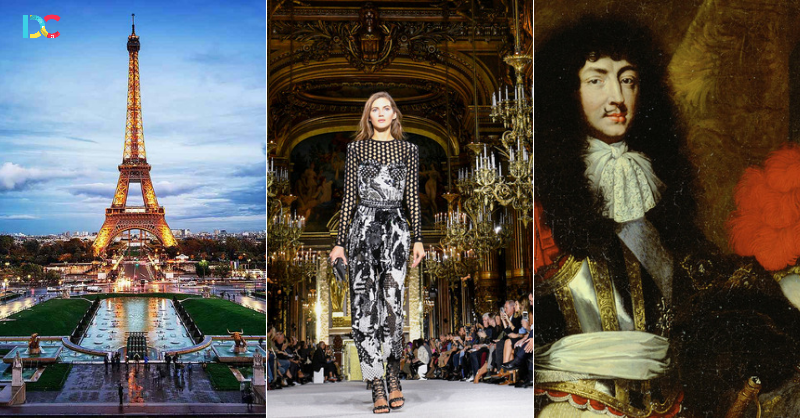Fashion
What makes France the undisputed Fashion Capital of the World?

France’s cultural influence, commitment to craftsmanship, and artistic flair continue to make it the epicenter of the global fashion industry. We are delving deeper into the fashion history of France to better understand it!
France has held the title of the fashion capital of the world for a long time, and it can be attributed to its rich history. France’s cultural influence, commitment to craftsmanship, and artistic flair continue to make it the epicenter of the global fashion industry. It’s no wonder that French fashion is synonymous with class, elegance, and sophistication. You might wonder, “Where did it all begin?” We are delving deeper into the fashion history of France to better understand it!
The Reign of Louis XIV and Political Tension in France:
It was during the reign of Louis XIV when the regulation of luxury goods industries came under royal control, and the French Court was known for its lavish taste in style. The prominence of fashion increased with the introduction of the fashion press in the 1670s, which brought the concept of fashion to a broader audience. The most noticeable fashion trend of the time, introduced by Louis XIV, included wigs of curled hair. Many believe that he chose to wear these wigs to hide signs of balding. Another royal known for her lavish taste was Marie Antoinette, and it didn’t take long for it to tarnish her reputation. Many historians and scholars believe that the queen was arguably the representative of class conflict, Western aristocracy, and absolutist government. The fashion changes in France influenced the political and economic conditions of the country. The extravagant tastes of French royals came at the expense of the poor, who faced enormous debts and taxation. In such a situation, the fashion preferences of Marie Antoinette ruined her reputation and somewhat also fueled rage in the population, which paved the way for the French Revolution.
Fashion as a Tool of Revolt:
The country was going through political and economic instability, leading to a revolt from the population. The fashion styles that the lower-class French citizens chose to wear were easily distinguishable from those of the royals. Sans-culottes were the working-class French peasants who fought for liberty during the French Revolution, and they used to wear patriotic clothes in coordination. They rejected wigs and knee-breeches and favored more informal styles. They wore a red cap of liberty, also called the Phrygian cap. This cap was a controversial symbol of rebellion worn by lower-class revolutionaries and had the official colors of blue, red, and white, which came together to form a tricolor cockade. These colors appeared in the dresses of French citizens who supported the French Revolution. Patriotic women notably wore dark uniforms adorned with the tricolor cockade.
The Rise of Haute Couture in the 19th Century:
Charles Frederick Worth was the man behind introducing Haute Couture to the world. He opened a shop on Rue de la Paix in Paris, along with many fashion houses like Paul Poiret and Madeleine Vionnet. It didn’t take long for France to become popular for its fashion, as it became a thriving hub for fashion enthusiasts. During this time, the world also witnessed the rise of Coco Chanel, which changed the fashion industry. The brand reinvented women’s clothing, making it more comfortable and stylish. Chanel favored loose and comfortable clothing, and this idea became a massive hit in the 1920s. However, the thriving fashion industry of France suffered a huge loss during the Second World War. Under the rise of the Nazis, many fashion houses, including Chanel, had to halt their production. The United States saw it as an opportunity to establish its presence in the fashion industry by diverting attention to famous American designers of that time, such as Claire McCardell.
Fashion After the Second World War:
The world grappled with the consequences of the Second World War. Amidst textile shortages and a lack of resources, Christian Dior emerged as a visionary with a plan to revive French fashion. Dior dominated the fashion scene after the Second World War with his new designs characterized by a waist cut and an A-line skirt reaching mid-calf, adopted by French women for its elegant silhouette. However, these extravagant clothes required complex and expensive manufacturing, leading to criticism of the brand. In response, Christian Dior famously said, “Europe has had enough bombs; now it wants to see fireworks.” Dior was inundated with orders at this time, and the brand restored Paris’s reputation as the fashion capital of the world.
A number of visionary designers emerged during the 20th century who maintained the country’s reputation as the fashion hub of the world, including Pierre Balmain and Hubert de Givenchy. France faced tough competition from the United States and Italy at that time. In the 1960s, youth culture emerged in London with Mary Quant, an English designer who brought a massive shift in the fashion world by introducing mini skirts and promoting bolder fashion and sexual liberation. Her style contradicted Parisian creations. However, it was Yves Saint Laurent who had the most significant impact on the fashion industry in the late 1960s. The brand brought many men’s products to women’s wardrobes, such as tuxedos, and was the first to produce ready-to-wear collections. Time has changed, but the influence of French fashion on the world is here to stay. Paris still undisputedly holds the title of the fashion capital of the world, along with Milan, New York, and London.”
Also Read – What’s so special about Hayao Miyazaki’s “The Boy and the Heron”
Follow Us – Dis_cultured
Pingback: These Indian Fashion Brands are Set to Dazzle at Moscow Fashion Week from March 1st to 8th - Discultured